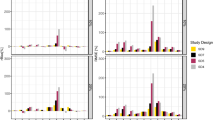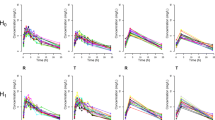Abstract
Although there is a body of literature focused on minimizing the effect of dosing inaccuracies on pharmacokinetic (PK) parameter estimation, most of the work centers on missing doses. No attempt has been made to specifically characterize the effect of error in reported dosing times. Additionally, existing work has largely dealt with cases in which the compound of interest is dosed at an interval no less than its terminal half-life. This work provides a case study investigating how error in patient reported dosing times might affect the accuracy of structural model parameter estimation under sparse sampling conditions when the dosing interval is less than the terminal half-life of the compound, and the underlying kinetics are monoexponential. Additional effects due to noncompliance with dosing events are not explored and it is assumed that the structural model and reasonable initial estimates of the model parameters are known. Under the conditions of our simulations, with structural model CV % ranging from ~20 to 60 %, parameter estimation inaccuracy derived from error in reported dosing times was largely controlled around 10 % on average. Given that no observed dosing was included in the design and sparse sampling was utilized, we believe these error results represent a practical ceiling given the variability and parameter estimates for the one-compartment model. The findings suggest additional investigations may be of interest and are noteworthy given the inability of current PK software platforms to accommodate error in dosing times.


Similar content being viewed by others
References
Gibiansky L, Gibiansky E, Cosson V, Frey N, Stark FS (2014) Methods to detect non-compliance and reduce its impact on population PK parameter estimates. J Pharmacokinet Pharmacodyn 41(3):279–289. doi:10.1007/s10928-014-9364-2
Li J, Nekka F (2007) A pharmacokinetic formalism explicitly integrating the patient drug compliance. J Pharmacokinet Pharmacodyn 34(1):115–139. doi:10.1007/s10928-006-9036-y
Lu J, Gries J-M, Verotta D, Sheiner LB (2001) Selecting reliable pharmacokinetic data for explanatory analyses of clinical trials in the presence of possible noncompliance. J Pharmacokinet Pharmacodyn 28(4):343–362
Soy D, Beal SL, Sheiner LB (2004) Population one-compartment pharmacokinetic analysis with missing dosage data. Clin Pharmacol Ther 76(5):441–451. doi:10.1016/j.clpt.2004.07.010
Diaz E, Levine HB, Sullivan MC, Sernyak MJ, Hawkins KA, Cramer JA, Woods SW (2001) Use of the Medication Event Monitoring System to estimate medication compliance in patients with schizophrenia. J Psychiatry Neurosci 26(4):325
Parker CS, Chen Z, Price M, Gross R, Metlay JP, Christie JD, Brensinger CM, Newcomb CW, Samaha FF, Kimmel SE (2007) Adherence to warfarin assessed by electronic pill caps, clinician assessment, and patient reports: results from the IN-RANGE study. J Gen Intern Med 22(9):1254–1259
Samet JH, Sullivan LM, Traphagen ET, Ickovics JR (2001) Measuring adherence among HIV-infected persons: Is MEMS consummate technology? AIDS Behav 5(1):21–30
Savic RM, Barrail-Tran A, Duval X, Nembot G, Panhard X, Descamps D, Verstuyft C, Vrijens B, Taburet A-M, Goujard C (2012) Effect of adherence as measured by MEMS, ritonavir boosting, and CYP3A5 genotype on atazanavir pharmacokinetics in treatment-naive HIV-infected patients. Clin Pharmacol Ther 92(5):575–583
Haberer J (2013) Medication Event Monitoring Systems. Encyclopedia of behavioral medicine. Springer, New York, pp 1215–1219
Gupta P, Hutmacher MM, Frame B, Miller R (2008) An alternative method for population pharmacokinetic data analysis under noncompliance. J Pharmacokinet Pharmacodyn 35(2):219–233. doi:10.1007/s10928-008-9085-5
Mu S, Ludden TM (2003) Estimation of population pharmacokinetic parameters in the presence of non-compliance. J Pharmacokinet Pharmacodyn 30(1):53–81
FDA Drugs@FDA. http://www.accessdata.fda.gov/scripts/cder/drugsatfda/. Accessed 23 Dec 2014
Bauer R (2011) NONMEM users guide introduction to NONMEM 7.2. 0. ICON Development Solutions, Ellicott City
R: A language and environment for statistical computing. (2014). R Foundation for Statistical Computing. http://www.R-project.org/, Vienna, Austria
Acknowledgments
The authors would like to thank Timothy Goggin for his valuable comments during the editorial process.
Author information
Authors and Affiliations
Corresponding author
Ethics declarations
Conflict of interest
The authors declare that there are no conflicts of interest.
Electronic supplementary material
Below is the link to the electronic supplementary material.
Rights and permissions
About this article
Cite this article
Knights, J., Rohatagi, S. A pharmacometric case study regarding the sensitivity of structural model parameter estimation to error in patient reported dosing times. J Pharmacokinet Pharmacodyn 42, 627–637 (2015). https://doi.org/10.1007/s10928-015-9428-y
Received:
Accepted:
Published:
Issue Date:
DOI: https://doi.org/10.1007/s10928-015-9428-y




